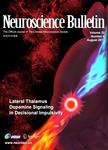Chemokine signaling involving chemokine (C-C motif) ligand 2 plays a role in descending pain facilitation
Chemokine signaling involving chemokine (C-C motif) ligand 2 plays a role in descending pain facilitation作者机构:Department of Neural and Pain Sciences School of Dentistry & Program in Neuroscience University of Maryland
出 版 物:《Neuroscience Bulletin》 (神经科学通报(英文版))
年 卷 期:2012年第28卷第2期
页 面:193-207页
核心收录:
学科分类:0710[理学-生物学] 1002[医学-临床医学] 1001[医学-基础医学(可授医学、理学学位)] 100104[医学-病理学与病理生理学] 10[医学]
基 金:supported by grants from the National Institutes of Health (NS059028 NS060735 DE011964 DE021804 and DE018573)
主 题:monocyte chemoattractant protein-l chemokine (C-C motif) receptor 2 rostral ventromedial medulla neu-ron-glial interaction neuropathic pain rat
摘 要:Objective Despite accumulating evidence on a role of immune cells and their associated chemicals in mecha- nisms of pain, few studies have addressed the potential role of chemokines in the descending facilitation of persistent pain. The present study was undertaken to test the hypothesis that the chemokine (C-C motif) ligand 2 (CCL2) (commonly known as monocyte chemoattractant protein-1) signaling in the rostral ventromedial medulla (RVM), a pivotal structure in brainstem pain modulatory circuitry, is involved in descending pain facilitation in rats. Methods An L5 spinal nerve ligation (SNL) was produced in rats under pentobarbital anesthesia. Western blot and immunohistochemistry were used to detect the expression levels of CCL2 and CCL2 receptor (CCR2), and examine their distributions compared with the neuronal marker NeuN as well as glial markers glial fibrillary acidic protein (GFAP, astroglial) and CD 11 b (microglial), respectively. Results SNL induced an increase in CCL2 expression in the RVM, and this returned to the control level at 4 weeks after injury. The induced CCL2 colocalized with NeuN, but not with GFAP and CD1 lb. CCR2 was also upregu- lated by SNL in the RVM, and this increase lasted for at least 4 weeks. CCR2 was colocalized with CD1 lb but not GFAP. Few RVM neurons also exhibited CCR2 staining. Neutralizing CCL2 with an anti-CCL2 antibody (0.2-20 ng) or injecting RS-102895 (0.1-10 pmol), a CCR2b chemokine receptor antagonist, into the RVM on day 1 after SNL, significantly at- tenuated the established thermal and mechanical hypersensitivity. In addition, injection of recombinant rat CCL2 (0.03-3 pmol) into the RVM induced dose-dependent hyperalgesia, which was prevented by pretreatment with RS-102895 (10 pmol). Interleukin-β (IL-1]3), a potent inducer of neuronal CCL2, was also selectively upregulated in RVM reactive as- trocytes. Injection of IL-1 ]3 (120 fmol) into the RVM induced behavioral hyperalgesia, which was blocked by RS-102895 (10 pmol



